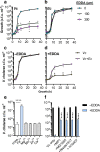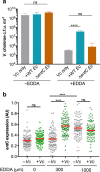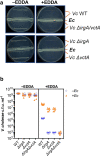Siderophore piracy enhances Vibrio cholerae environmental survival and pathogenesis
- PMID: 33074088
- PMCID: PMC7723260
- DOI: 10.1099/mic.0.000975
Siderophore piracy enhances Vibrio cholerae environmental survival and pathogenesis
Abstract
Vibrio cholerae, the aetiological agent of cholera, possesses multiple iron acquisition systems, including those for the transport of siderophores. How these systems benefit V. cholerae in low-iron, polymicrobial communities in environmental settings or during infection remains poorly understood. Here, we demonstrate that in iron-limiting conditions, co-culture of V. cholerae with a number of individual siderophore-producing microbes significantly promoted V. cholerae growth in vitro. We further show that in the host environment with low iron, V. cholerae colonizes better in adult mice in the presence of the siderophore-producing commensal Escherichia coli. Taken together, our results suggest that in aquatic reservoirs or during infection, V. cholerae may overcome environmental and host iron restriction by hijacking siderophores from other microbes.
Keywords: Anabaena variabilis; Cunninghamella elegans; Escherichia coli; Vibrio cholerae; Vibrio fluvialis; colonization; enterobactin; iron.
Conflict of interest statement
The authors declare that there are no conflicts of interest.
Figures






Similar articles
-
Catechol Siderophore Transport by Vibrio cholerae.J Bacteriol. 2015 Sep;197(17):2840-9. doi: 10.1128/JB.00417-15. Epub 2015 Jun 22. J Bacteriol. 2015. PMID: 26100039 Free PMC article.
-
The Vibrio cholerae VctPDGC system transports catechol siderophores and a siderophore-free iron ligand.Mol Microbiol. 2011 Sep;81(6):1446-58. doi: 10.1111/j.1365-2958.2011.07775.x. Epub 2011 Aug 4. Mol Microbiol. 2011. PMID: 21790806 Free PMC article.
-
Identification of the Vibrio cholerae enterobactin receptors VctA and IrgA: IrgA is not required for virulence.Infect Immun. 2002 Jul;70(7):3419-26. doi: 10.1128/IAI.70.7.3419-3426.2002. Infect Immun. 2002. PMID: 12065481 Free PMC article.
-
Iron acquisition in Vibrio cholerae.Biometals. 2007 Jun;20(3-4):405-16. doi: 10.1007/s10534-006-9073-4. Epub 2007 Jan 10. Biometals. 2007. PMID: 17216354 Review.
-
Signal transduction and transcriptional and posttranscriptional control of iron-regulated genes in bacteria.Microbiol Mol Biol Rev. 1997 Sep;61(3):319-36. doi: 10.1128/mmbr.61.3.319-336.1997. Microbiol Mol Biol Rev. 1997. PMID: 9293185 Free PMC article. Review.
Cited by
-
Proteomic Analysis of the Fish Pathogen Vibrio ordalii Strain Vo-LM-18 and Its Outer Membrane Vesicles.Animals (Basel). 2024 Dec 13;14(24):3598. doi: 10.3390/ani14243598. Animals (Basel). 2024. PMID: 39765502 Free PMC article.
-
A Metabolite Produced by Gut Microbes Represses Phage Infections in Vibrio cholerae.ACS Chem Biol. 2022 Sep 16;17(9):2396-2403. doi: 10.1021/acschembio.2c00422. Epub 2022 Aug 12. ACS Chem Biol. 2022. PMID: 35960903 Free PMC article.
-
Vibrio cholerae was found in cultured bullfrog.Epidemiol Infect. 2022 Feb 8;150:e30. doi: 10.1017/S0950268822000164. Epidemiol Infect. 2022. PMID: 35130995 Free PMC article.
-
A long journey to the colon: The role of the small intestine microbiota in intestinal disease.Mol Microbiol. 2024 Sep;122(3):304-312. doi: 10.1111/mmi.15270. Epub 2024 May 1. Mol Microbiol. 2024. PMID: 38690771 Review.
-
Xenosiderophores: bridging the gap in microbial iron acquisition strategies.World J Microbiol Biotechnol. 2025 Feb 13;41(2):69. doi: 10.1007/s11274-025-04287-w. World J Microbiol Biotechnol. 2025. PMID: 39939429 Review.
References
Publication types
MeSH terms
Substances
Grants and funding
LinkOut - more resources
Full Text Sources
Molecular Biology Databases

